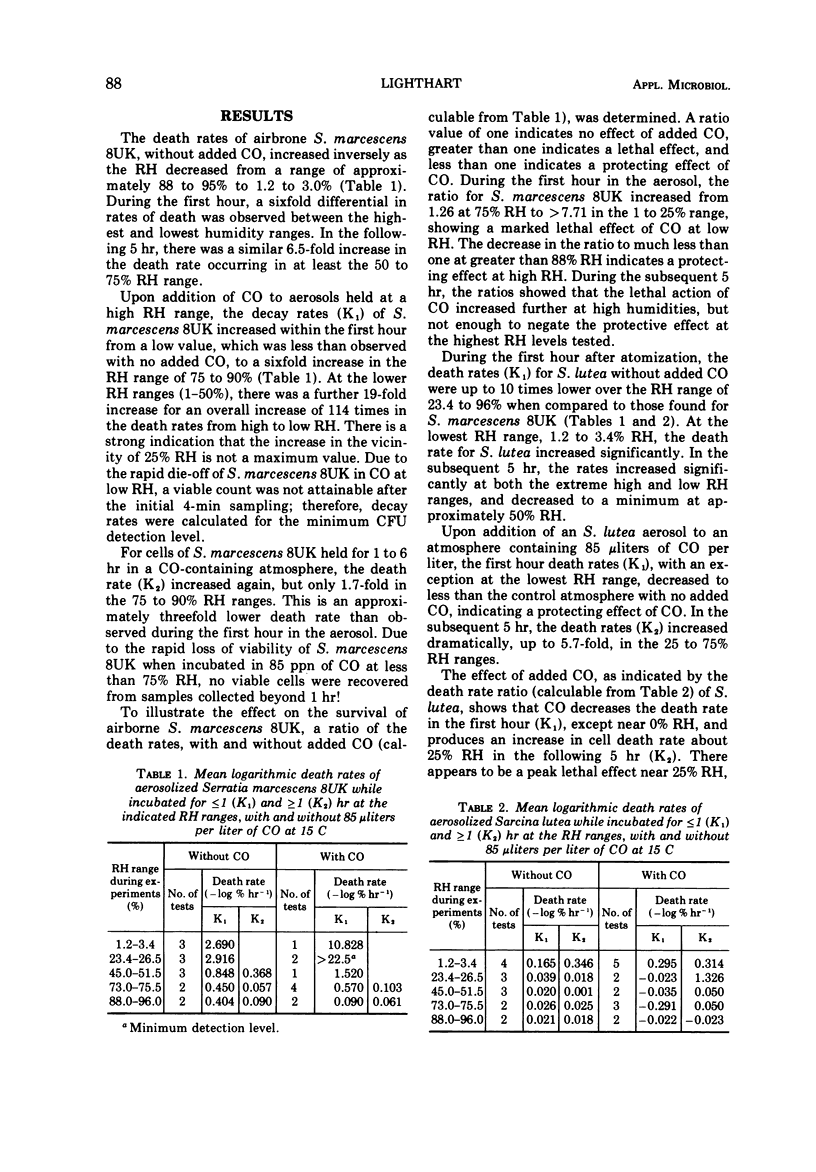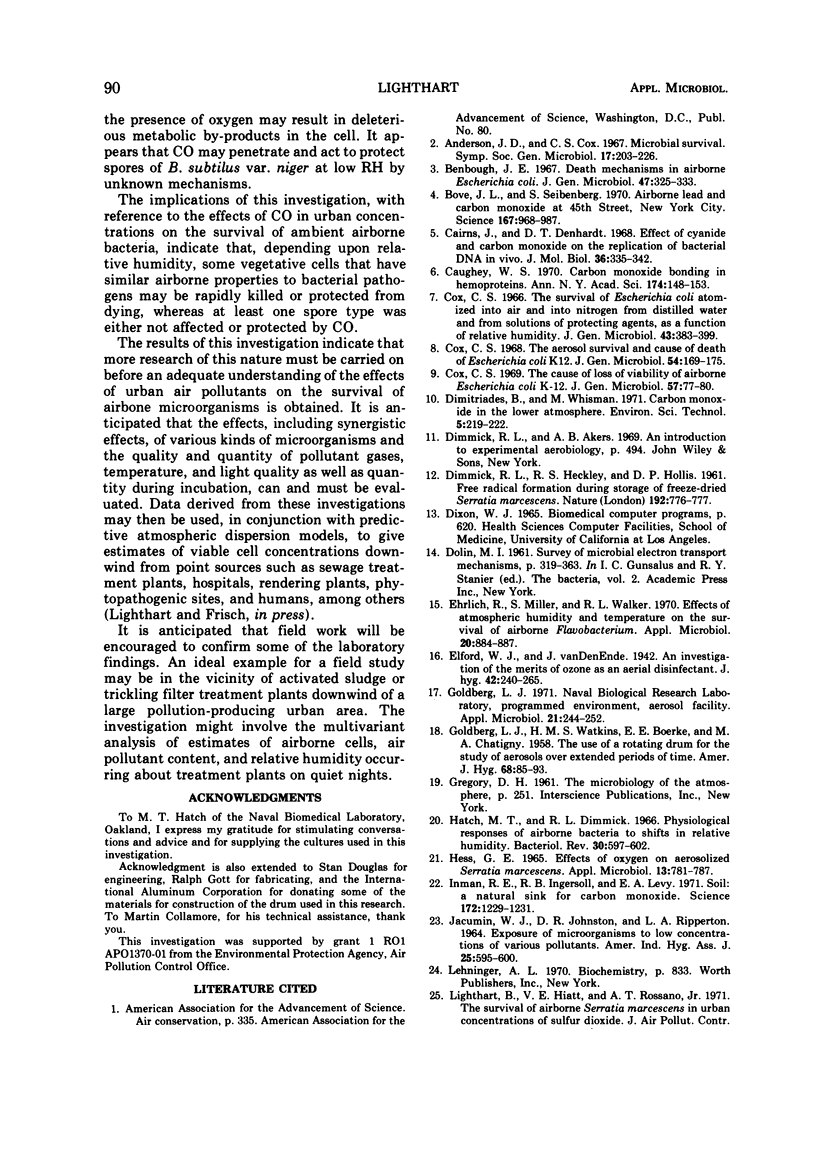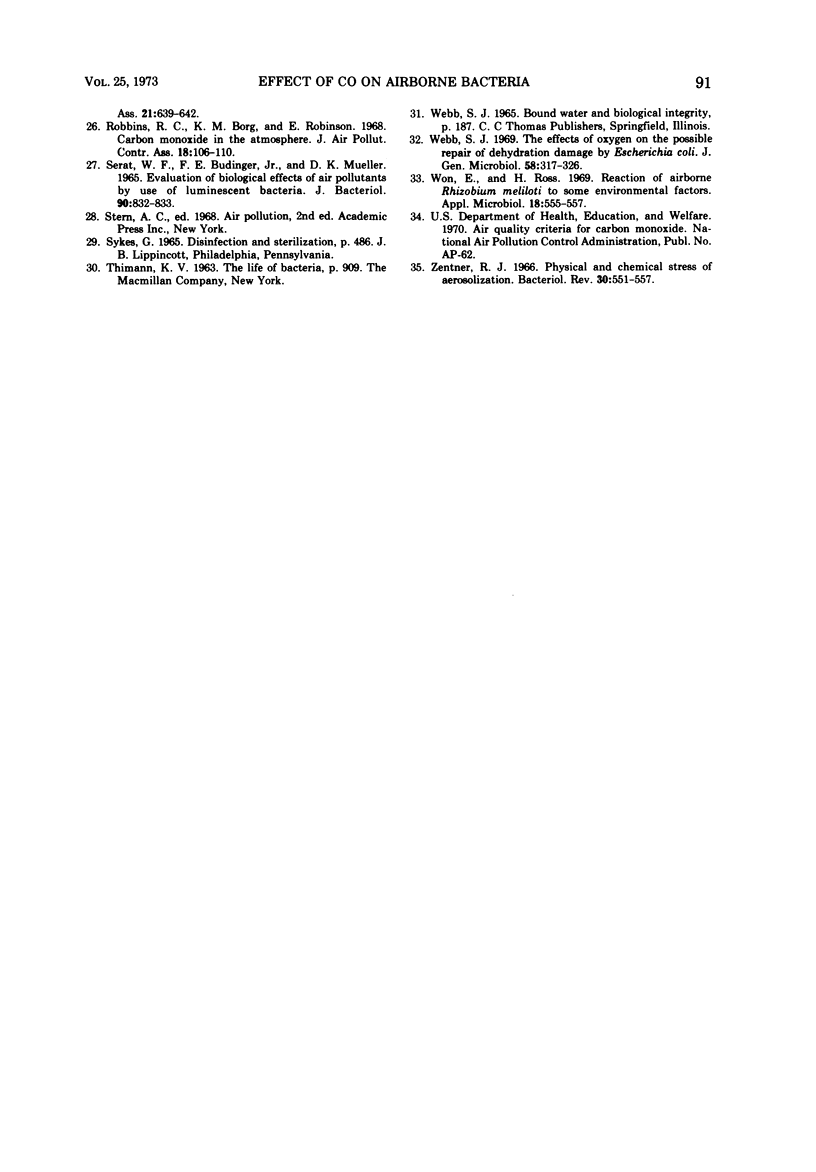Abstract
Vegetative cells of Serratia marcescens 8UK, Sarcina lutea, and spores of Bacillus subtilus var. niger were held in aerosols, with and without an urban concentration of CO (85 μliters per liter or ppm), for up to 6 hr at 15 C and a relative humidity (RH) of approximately 0, 25, 50, 75, and 95%. It was found that CO enhanced the death rate of S. marcescens 8UK at least four- to sevenfold at low RH (ca. 1 to 25%), but protected the cells at high RH (ca. 90%). Death rates of S. lutea, with or without added CO, were comparatively low over the entire RH range. However, in the first hour, airborne S. lutea held in CO-containing air were more stable than those in air without added CO (i.e., CO protection). A marked increase in the death rate (up to 70-fold) occurred in the subsequent 5 hr within the RH range of approximately 0 to 75%. Statistical analysis indicated that aerosol decay rates of B. subtilus var. niger spores decreased significantly, when held in a CO-containing as compared to a non-CO-containing atmosphere, in the 0 to 85% RH range. Thus, the data presented indicate that CO in the urban environment may have a protective or lethal effect on airborne bacteria, dependent upon at least the microbial species, aerosol age, and relative humidity. A mechanism for CO death enhancement and protection of airborne S. marcescens 8UK is suggested to involve CO uncoupling of an energy-requiring death mechanism and an energy-requiring maintenance mechanism at high and low RH, respectively.
Full text
PDF





Selected References
These references are in PubMed. This may not be the complete list of references from this article.
- Benbough J. E. Death mechanisms in airborne Escherichia coli. J Gen Microbiol. 1967 Jun;47(3):325–333. doi: 10.1099/00221287-47-3-325. [DOI] [PubMed] [Google Scholar]
- Bové J. L., Siebenberg S. Airborne lead and carbon monoxide at 45th Street, New York City. Science. 1970 Feb 13;167(3920):986–987. doi: 10.1126/science.167.3920.986. [DOI] [PubMed] [Google Scholar]
- Cairns J., Denhardt D. T. Effect of cyanide and carbon monoxide on the replication of bacterial DNA in vivo. J Mol Biol. 1968 Sep 28;36(3):335–342. doi: 10.1016/0022-2836(68)90159-9. [DOI] [PubMed] [Google Scholar]
- Caughey W. S. Carbon monoxide bonding in hemeproteins. Ann N Y Acad Sci. 1970 Oct 5;174(1):148–153. doi: 10.1111/j.1749-6632.1970.tb49781.x. [DOI] [PubMed] [Google Scholar]
- Cox C. S. The aerosol survival and cause of death of Escherichia coli K12. J Gen Microbiol. 1968 Dec;54(2):169–175. doi: 10.1099/00221287-54-2-169. [DOI] [PubMed] [Google Scholar]
- Cox C. S. The cause of loss of viability of airborne Escherichia coli K12. J Gen Microbiol. 1969 Jul;57(1):77–80. doi: 10.1099/00221287-57-1-77. [DOI] [PubMed] [Google Scholar]
- Cox C. S. The survival of Escherichia coli sprayed into air and into nitrogen from distilled water and from solutions of protecting agents, as a function of relative humidity. J Gen Microbiol. 1966 Jun;43(3):383–399. doi: 10.1099/00221287-43-3-383. [DOI] [PubMed] [Google Scholar]
- Ehrlich R., Miller S., Walker R. L. Effects of atmospheric humidity and temperature on the survival of airborne Flavobacterium. Appl Microbiol. 1970 Dec;20(6):884–887. doi: 10.1128/am.20.6.884-887.1970. [DOI] [PMC free article] [PubMed] [Google Scholar]
- GOLDBERG L. J., WATKINS H. M., BOERKE E. E., CHATIGNY M. A. The use of a rotating drum for the study of aerosols over extended periods of time. Am J Hyg. 1958 Jul;68(1):85–93. doi: 10.1093/oxfordjournals.aje.a119954. [DOI] [PubMed] [Google Scholar]
- Hatch M. T., Dimmick R. L. Physiological responses of airborne bacteria to shifts in relative humidity. Bacteriol Rev. 1966 Sep;30(3):597–603. doi: 10.1128/br.30.3.597-603.1966. [DOI] [PMC free article] [PubMed] [Google Scholar]
- Hess G. E. Effects of oxygen on aerosolized Serratia marcescens. Appl Microbiol. 1965 Sep;13(5):781–787. doi: 10.1128/am.13.5.781-787.1965. [DOI] [PMC free article] [PubMed] [Google Scholar]
- Inman R. E., Ingersoll R. B., Levy E. A. Soil: a natural sink for carbon monoxide. Science. 1971 Jun 18;172(3989):1229–1231. doi: 10.1126/science.172.3989.1229. [DOI] [PubMed] [Google Scholar]
- JACUMIN W. J., JOHNSTON D. R., RIPPERTON L. A. EXPOSURE OF MICROORGANISMS TO LOW CONCENTRATIONS OF VARIOUS POLLUTANTS. Am Ind Hyg Assoc J. 1964 Nov-Dec;25:595–600. doi: 10.1080/00028896409342649. [DOI] [PubMed] [Google Scholar]
- Robbins R. C., Borg K. M., Robinson E. Carbon monoxide in the atmosphere. J Air Pollut Control Assoc. 1968 Feb;18(2):106–110. doi: 10.1080/00022470.1968.10469094. [DOI] [PubMed] [Google Scholar]
- Serat W. F., Budinger F. E., Mueller P. K. Evaluation of Biological Effects of Air Pollutants by Use of Luminescent Bacteria. J Bacteriol. 1965 Sep;90(3):832–833. doi: 10.1128/jb.90.3.832-833.1965. [DOI] [PMC free article] [PubMed] [Google Scholar]
- Webb S. J. The effects of oxygen on the possible repair of dehydration damage by Escherichia coli. J Gen Microbiol. 1969 Nov;58(3):317–326. doi: 10.1099/00221287-58-3-317. [DOI] [PubMed] [Google Scholar]
- Won W. D., Ross H. Reaction of airborne Rhizobium meliloti to some environmental factors. Appl Microbiol. 1969 Oct;18(4):555–557. doi: 10.1128/am.18.4.555-557.1969. [DOI] [PMC free article] [PubMed] [Google Scholar]
- Zentner R. J. Physical and chemical stresses of aerosolization. Bacteriol Rev. 1966 Sep;30(3):551–558. doi: 10.1128/br.30.3.551-558.1966. [DOI] [PMC free article] [PubMed] [Google Scholar]


